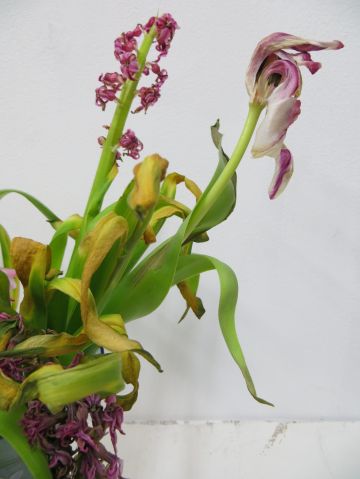I’ve been thinking for a while about taking some of my found objects outside of the studio. In this particular case, my collection of china swans – out onto a pond or lake, setting them free to swim or whatever else they felt inclined to do. In actual fact, what they did do was sink! – into the murky waters of a pond – covered in green algae in no time.
I was excited about doing something more spontaneous with my work and it seemed like the minute I put out a call amongst friends about finding an accessible pond with reeds and waterlilies, I got a response. But I took the word spontaneous a bit too literally I think and turned up, china swans to hand, without properly thinking things through. For a number of reasons then, the ideas I had just didn’t work. I was pleased that I’d also taken along one of my favourite Vernon Ward paintings because the photos I took of it did, at least, seem to work in some way.
This was all last Wednesday when I took a rare complete day off to spend time with friends. I was lucky to be able to take my art with me and to be allowed time to play and experiment on my own for a couple of hours in the lovely grounds of a friend of a friend’s home. The home is situated in the most beautiful surroundings – right in the midst of woodland, currently covered with bluebells, wild primroses and wood anenomes and surrounded by three large ponds. It felt really liberating to be outside, especially after the long recent stretch of being confined to indoors – sorting.
Messing around amongst the ponds and reeds and seeing the wild flowers at their very best in the surrounding woodland, took me right back to my childhood – vivid, happy memories of growing up in the countryside. The Vernon Ward painting I took with me and photographed on the pond’s edge is rather aptly called ‘Harmony in Spring.’
Despite not getting the results I’d hoped for, it was great to have an opportunity to experiment – there aren’t any places I know in London (or anywhere else for that matter) where I’d be able to play around with twenty or so china swans for a couple of hours without being asked a) what I was up to and b) in the interests of health & safety, would I please leave?
Yesterday, for the third time this month, I was in the heart of the country again – very close to Bury St. Edmund’s, celebrating a friend’s birthday. I was in the region a couple of weekends before as well, staying with relatives in a place in Suffolk, close to the Cambridgeshire borders where I was born and raised for the first fifteen years of my life.
In spite of not having lived there for a number of years, it still feels a bit like going home whenever I return to the area – the familiar, flat agricultural landscape of the fenlands and the nearby villages, so reminiscent of the one I was born in; my late Nana, who has had such a big influence on my creative practice, is never far from my thoughts.
Coincidentally, while idly looking through an old notebook last week, I came across a Wikipedia reference which I earmarked some time ago. So much of it resonates, reminding me of my relationship with my own Grandmother and her legacy of respecting the things we own – cherishing and looking after them. Writing about the psychology of collecting, Oxlade-Vas describes the:
‘ … intense emotional bond she had with her grandmother, and the rich heart-warming memories she had amassed at her grandma’s house as a child and even as an adult.’
‘Her grandmother, a product of the Great Depression ‘saved’ everything. As a child, the author recalls the loving and gentle way her grandmother organized seemingly ordinary items: rubber bands were neatly bound together and artfully displayed on the mantle. Tops of pens of all colors and sizes were neatly arranged in drawers and bins. Artificial flowers, saved from the dumpster decorated every room in the house. At her grandmother’s death, Oxlade-Vaz recalls the overwhelmingly pleasant emotions that overcame her as she sorted through her grandma’s collections. Though not valuable, the author kept these collections to remember her grandma’s thrifty, sensible, wisdom- reminders of the graceful way her grandmother was able to provide seemingly useless items dignity and respect.’










